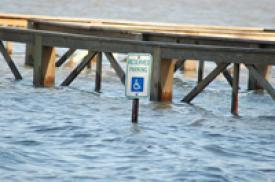Sand Hill, Ark. - Volunteers armed with sandbags held back water springing up from under a rural levee Tuesday as the White River continued its highest surge in a quarter-century through eastern Arkansas.

|
| ©Jim Williamson
|
| Flood waters submerge a fishing pier and parking lot Monday morning at Beard's Bluff on Millwood Lake. Heavy rains from last week's storms left the lake about 8 foot higher than normal. Rising water continues to wreak havoc across the state, with 35 counties declared disaster areas.
|
The National Weather Service issued a flash flood warning during the morning for rural Prairie County north of Interstate 40 after spotters noticed the levee had "sand boils" - water passing under the earthen barrier and appearing on the side like a muddy spring. By the afternoon, 100 volunteers held back the flow by building sandbag barriers for the water to be held in, creating pressure to stem the tide.
Thomas "Babe" Vincent, a levee district board member, praised the spirit of the volunteers.
"We've had people here today from the other side of the river who aren't in danger," Vincent said.
After heavy rains last week, major rivers overflowed their banks, inundating north and central Arkansas and driving people from their homes and businesses. Almost half the state - 35 counties - was declared a disaster area.
Tuesday, the waters continued to rise even as the sun was shining. The Army Corps of Engineers did not expect the White River to crest down river at Clarendon until Friday at 33.5 feet.
Gov. Mike Beebe, on hand to visit some volunteers at the levee, described seeing the "devastating" flooding from the air on a recent helicopter trip across the state.
"It looked like just a solid lake from Batesville to Newport - you couldn't tell where the river was," the governor said.
Beebe said disaster relief to those affected likely would come from the Federal Emergency Management Agency. Teams of state and federal officials were deployed Tuesday to examine flood-damaged buildings and businesses. Officials first put damages at $2 million, but said it would likely rise well above that once the waters recede.
Bob Alvey, a spokesman for the FEMA, said teams would spread across counties in northwest Arkansas first, then move to Arkansas' prairie.
"We're hitting areas we can get to because a lot of areas we can't get to," Alvey said.
Meanwhile, residents in east-central Arkansas did what little they could Tuesday while waiting for flood waters to subside.
Standing on a levee and taking photographs to document the damage, Karen Phillips gazed stoically at her home, where the White River had intruded two days earlier. Phillips expected to have to stay another night in a hotel.
Donald Holland and his wife moved three goats and nine chickens to higher ground but were having trouble finding their turkeys. Holland was so distracted he forgot it was his 68th birthday.
"The water's about a foot deep around my trailer," Holland said during a break from searching for a gobbler and a hen. "I've got my boat tied up to my front porch."
The flooding was particularly unnerving to wheat farmers whose investments were under water.
"I'm sure the (flooded) acreage numbers are much greater than we envisioned last week when the rain started - tens of thousand of acres, I'm sure," said wheat agronomist Jason Kelley of the University of Arkansas Cooperative Extension Service.
Kelley said the flooding would reduce yields and may kill crops in some places, depending on how long the water stands. All the money farmers invested in their crops could be lost, he said.
The weather service said the Black River in northeast Arkansas had crested but would take several days for the flood waters to recede.
Reader Comments
to our Newsletter